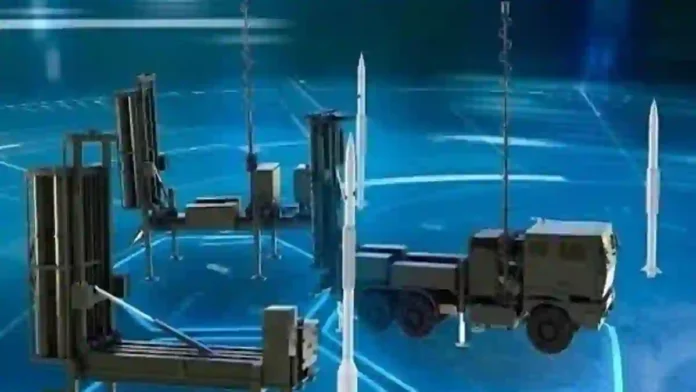India’s Project Kusha represents a significant breakthrough in indigenous air defence technology, aiming to develop a multi-layered, long-range surface-to-air missile (SAM) system comparable to or even surpassing Russia’s advanced S-400 and S-500 systems. Spearheaded by the Defence Research and Development Organisation (DRDO) with support from Bharat Electronics Limited (BEL) and other Indian defence entities, Project Kusha seeks to reduce India’s dependence on imported high-end missile defence systems, especially Russian ones, amid shifting geopolitical circumstances.
Project Kusha is being engineered as a comprehensive air defence architecture to neutralize a broad spectrum of aerial threats, including enemy aircraft, cruise missiles, stealth fighters, drones, airborne early warning and control systems, anti-ship ballistic missiles, and hypersonic threats potentially reaching speeds of Mach 7.
Read- India’s Missile Might Versus Pakistan’s Failed Missile Flights
The system is planned to be multi-layered, consisting primarily of three interceptor missile variants—M1, M2, and M3—with respective ranges of approximately 150 km, 250 km, and 350-400 km. These interceptors are designed to cover tactical to strategic aerial engagements with a sophisticated kill vehicle technology shared among the variants but equipped with varying booster sizes for range optimization.
M1 Interceptor (150 km Range): Compact and agile, equipped with a 250 mm diameter kill vehicle with dual-pulse solid rocket motor and thrust vector control, optimized for engaging fighter jets, drones, and cruise missiles at shorter ranges.
M2 Interceptor (250 km Range): Also using a 250 mm kill vehicle but optimized for mid-range threats, including AEW&CS platforms and anti-ship ballistic missiles.
M3 Interceptor (350-400 km Range): The longest-range missile with a larger 450 mm diameter kill vehicle, designed for long-range air threats like AWACS and electronic warfare platforms, ballistic missiles (short and medium range), aiming for an 85-98% kill probability depending on firing mode.
The design leverages technological advances from India’s Ballistic Missile Defence (BMD) program, using proven structures and subsystems to enhance development efficiency and capability. Integration with the Indian Air Force’s Integrated Air Command and Control System (IACCS) will enable seamless coordination with existing defence assets such as Akash, Barak-8, and the Russian-supplied S-400 systems, to create a layered and networked air defence shield.
Read- India’s New ‘Pralay’ Missile Can Deliver A 1000 Kg Punch
Read- India Developing Next-Gen Destroyer That Can Carry 144 Missiles, Including BrahMos
Project Kusha’s radar and sensor suite is expected to include active electronically scanned array (AESA) radars, advanced long-range surveillance, and fire control radars capable of scanning 500-600 km into enemy territory, with future upgrades potentially extending detection range up to 1,500 km.
This comprehensive sensing capability supports real-time tracking and target engagement, aided by AI-enabled decision support systems to optimize interceptor deployment and engagement tactics against stealthy, fast-moving, or hypersonic targets.
Strategically, Project Kusha is critical for India’s objectives to achieve self-reliance (Atmanirbhar Bharat) in defence technology and to reduce vulnerabilities from geopolitical dependencies on foreign suppliers, particularly Russia, from whom India previously imported systems like the S-400 and Akash variants.
The anticipated induction timeline targets operational deployment between 2028 and 2030, with phased development advancing through multiple stages. Phase I focuses on the initial three-tier missile variants, while Phase II and possibly Phase III aim to introduce longer-range interceptors and enhance capabilities for hypersonic missile defence, rivalling or surpassing the capabilities of Russia’s S-500 “Prometheus” system.
Read- Modi Government Rejects U.S. F-35 Jets, Upholds Atmanirbharta
If successful, Project Kusha will position India among the few nations globally possessing a domestically developed hypersonic-capable layered air defence system, providing strategic depth and a decisive advantage in contested airspace scenarios across South Asia and beyond. It reflects India’s strategic foresight to prepare for increasingly sophisticated aerial threats in the future battlefield environment while fostering indigenous innovation within its defence industrial base.
Project Kusha is a cutting-edge, indigenous long-range air defence initiative by India’s DRDO aimed at producing a system rivaling the Russian S-400 and S-500. It features multi-tier interceptor missiles, advanced radar and sensor technologies, AI-driven engagement management, and integration with existing defence assets to provide a comprehensive shield against modern aerial threats such as stealth aircraft, ballistic and cruise missiles, and hypersonic weapons. The program is emblematic of India’s push for self-reliance and technological sovereignty in defence, with a prospective deployment timeline within the next 5 years.
Based On Republic World Report
Agency




